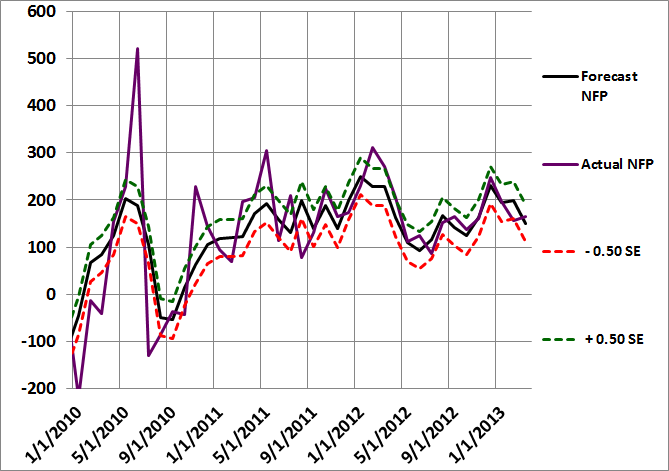This article presents the Trader Edge aggregate neural network model forecast for the February 2013 non-farm payroll data, which will be released tomorrow morning.
Non-Farm Payroll (NFP) Model Forecast - February 2013
The table in Figure 1 below includes the monthly non-farm payroll data for two months: January and February 2013. The January data was released last month and the non-farm payroll data for February 2013 will be released tomorrow morning at 8:30 AM EST.
The model forecasts are in the third data row of the table (in black). Note that past and current forecasts reflect the latest values of the independent variables, which means that forecasts will change when revisions are made to the historical economic data.
The monthly standard error of the model is approximately 78,600 jobs, which is lower than the previous models, but is still significant. The first and last data rows of the table report the forecast plus 0.5 standard errors (in green) and the forecast minus 0.5 standard errors (in red), respectively. All values are rounded to the nearest thousand. Assuming the model errors are normally distributed, roughly 31% of the observations would fall below -0.5 standard errors and another 31% of the observations would exceed +0.5 standard errors.
The actual non-farm payroll release for January 2013 is in the second data row of the table (in purple). The consensus estimate (reported by Briefing.com) for February 2013 is also in the second data row of the table (in purple). The reported and consensus NFP values also include the deviation from the forecast NFP (as a multiple of the standard error of the estimate). Finally, the last column of the table includes the estimated changes from January to February 2013.
Model Commentary
The model forecast for February is 151,000, which is down 49,000 from last month's revised forecast of 200,000. The Briefing.com consensus estimate for February is 165,000, which is 0.18 standard errors above the model forecast. The actual NFP observation was significantly lower than the revised model forecast in January, which is one reason the forecast for February declined by 49,000. Lagged NFP data are used as explanatory variables in the neural network models.
As you can see from the graph in Figure 2 below, the trend in job growth is now inching lower after reaching a peak in December 2012.
Summary
Basic forecasting tools can help you identify unusual consensus economic estimates, which often lead to substantial surprises and market movements. Identifying such environments may help you protect your portfolio from these corrections and help you determine the optimal entry and exit points for your strategies. In addition, significant deviations from the new model's forecasts may foretell subsequent moves in the equity markets and the economy.
Feedback
Your comments, feedback, and questions are always welcome and appreciated. Please use the comment section at the bottom of this page or send me an email.
Referrals
If you found the information on www.TraderEdge.Net helpful, please pass along the link to your friends and colleagues or share the link with your social or professional networks.
The "Share / Save" button below contains links to all major social and professional networks. If you do not see your network listed, use the down-arrow to access the entire list of networking sites.
Thank you for your support.
Brian Johnson
Copyright 2013 - Trading Insights, LLC - All Rights Reserved.















The February NFP came in at +236, well above the model forecast of +151. However, keep in mind that the January NFP was revised from +157 to +119. The combined January and February forecast was +351 and the actual aggregate NFP for January and February was +355.
The decline in January NFP simply moved jobs from January to February.
Brian Johnson